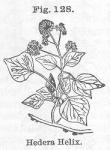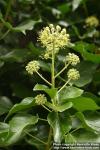
 The leaves, berries, and gum-resin of Hedera Helix, Linné.
The leaves, berries, and gum-resin of Hedera Helix, Linné.
Nat. Ord.—Araliaceae.
COMMON NAMES: Ivy, Common ivy.
Botanical Source.—This is an evergreen creeper, with long and flexible stems and branches, which attach themselves to the earth, or trees, or walls, by numerous root-like fibers. The leaves are coriaceous, smooth, shining, dark-green, with veins petiolate, the lower ones 5-angled or 5-lobed, the upper or old ones ovate and acute. The flowers are greenish-white, disposed in numerous, simple, and downy umbels, forming a corymb. The berries are black, with a mealy pulp (W.—L.).
History, Description, and Chemical Composition.—This plant is common all over Europe, and is cultivated in many parts of the United States; it flowers in September. The gum-resin (Gummiresina Hederae, or Ivy gum), exudes from the incised bark, and comes to us in yellowish or red-brown, irregular pieces. The edges are translucent and of a garnet hue. It is acrid, faintly bitter, and when heated emits a pleasant, aromatic odor. The leaves and berries are the parts used. The former possess a peculiar, rather fragrant odor, and a nauseously bitter and astringent taste. The taste of the latter is somewhat acid, piquant, and terebinthine. A. Jandous (Amer. Jour. Pharm., 1883, p. 371), reports the ivy berries to contain in their fleshy part 70 per cent of water, a dark-red coloring matter soluble in alcohol and water, resinous matter first tasting sweet, then sharp and bitter, and grape sugar, gum, albumin, and salts. The seeds contain a fatty oil of irritating taste and producing a green color with ferric chloride. The poisonous properties of the fruit are neither due to the resinous matter in the pulp, nor to the oil in the seeds.
A bitter substance believed to be an alkaloid and named hederin, was obtained from the seeds by Vendamme and Chevalier (see Amer. Jour. Pharm., 1842, p. 172). Posselt, in 1849, isolated from the seeds two proximate principles, viz., crystallizable hederic acid (C16H26O4, according to Davies, 1878), which Kingzett believed to be a glucosid, and amorphous hederatannic acid. (For details regarding these substances see Husemann and Hilger, Pflanzenstoffe, p, 968.) The bitter hederin is probably identical with hederatannic acid. The leaves of ivy have a peculiar fragrant odor and an astringent, bitter taste. Mr. F. A. Hartsell, in 1875, by extraction with 85 per cent alcohol, obtained therefrom in impure form, a glucosid resembling saponin, but differing from the latter by not being soluble in water. L. Vernet (Jour. Pharm. Chim., 1881, p. 347), isolated this glucosid (C32H54O11), which was later named helixin (Joulin, Jour. Pharm. Chim., 1891, p. 215), by boiling out the bruised leaves with water repeatedly, then extracting them with alcohol, evaporating the latter, washing with cold benzin, and crystallizing from solution in boiling acetone. It forms silky needles melting at 233° C. (451.4° F.), insoluble in water, chloroform, and benzin, soluble in warm acetone, benzol, and ether; also in warm alkalies and hot alcohol. It reduces Fehling's solution only after being heated with diluted sulphuric acid, sugar, and a neutral, crystallizable substance (C26H44O6), melting at 278° to 280° C. (532.4° to 536° F.), being formed. The latter is not fermentable with yeast; helixigenin is the name recorded for the helixin derivative in C. E. Sohn's Dict. Active Principles of Plants, 1894.
Action, Medical Uses, and Dosage.—The leaves are stimulating, and have been employed as an application to issues; and have likewise been efficient in diseases the skin, indolent ulcers, eczemas, itch, etc., in the form of decoction, and applied locally; this will also destroy vermin in the hair, which, it is stated, is stained black by the application. They are reputed beneficial as a cataplasm in glandular enlargements. Marasmus of children, rachitis, and pulmonary affections have been benefited by the dried leaves in powder, in doses of 20 grains or more. The berries act as an emetic and cathartic, and were formerly esteemed in febrile affections, having been supposed to possess sudorific virtues. Associated with vinegar, they were considerably used during the London plague. The gum-resin has been used for toothache, ulcerations, local pains, and to control excessive discharges.

